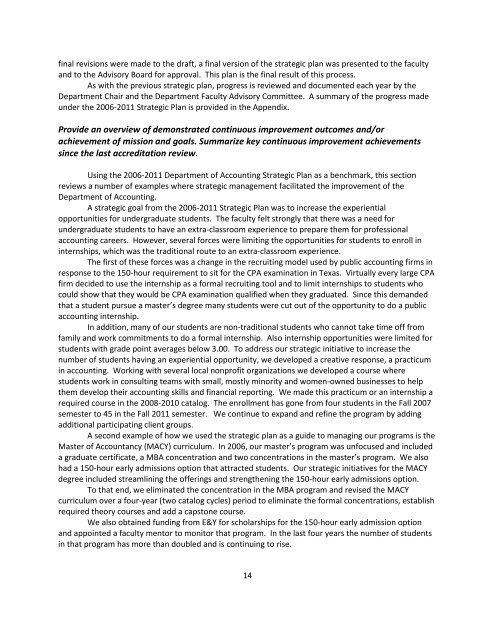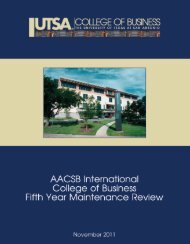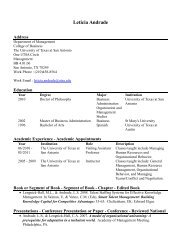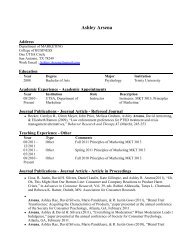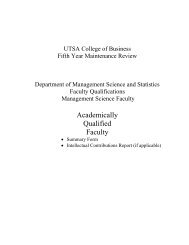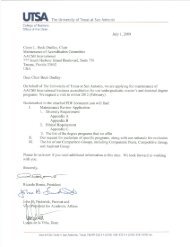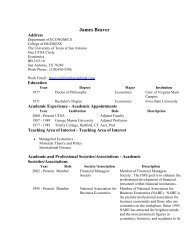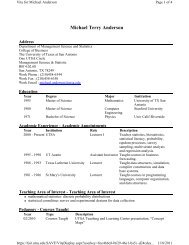Fifth Year Maintenance Report - AACSB - The University of Texas at ...
Fifth Year Maintenance Report - AACSB - The University of Texas at ...
Fifth Year Maintenance Report - AACSB - The University of Texas at ...
- No tags were found...
Create successful ePaper yourself
Turn your PDF publications into a flip-book with our unique Google optimized e-Paper software.
final revisions were made to the draft, a final version <strong>of</strong> the str<strong>at</strong>egic plan was presented to the facultyand to the Advisory Board for approval. This plan is the final result <strong>of</strong> this process.As with the previous str<strong>at</strong>egic plan, progress is reviewed and documented each year by theDepartment Chair and the Department Faculty Advisory Committee. A summary <strong>of</strong> the progress madeunder the 2006-2011 Str<strong>at</strong>egic Plan is provided in the Appendix.Provide an overview <strong>of</strong> demonstr<strong>at</strong>ed continuous improvement outcomes and/orachievement <strong>of</strong> mission and goals. Summarize key continuous improvement achievementssince the last accredit<strong>at</strong>ion review.Using the 2006-2011 Department <strong>of</strong> Accounting Str<strong>at</strong>egic Plan as a benchmark, this sectionreviews a number <strong>of</strong> examples where str<strong>at</strong>egic management facilit<strong>at</strong>ed the improvement <strong>of</strong> theDepartment <strong>of</strong> Accounting.A str<strong>at</strong>egic goal from the 2006-2011 Str<strong>at</strong>egic Plan was to increase the experientialopportunities for undergradu<strong>at</strong>e students. <strong>The</strong> faculty felt strongly th<strong>at</strong> there was a need forundergradu<strong>at</strong>e students to have an extra-classroom experience to prepare them for pr<strong>of</strong>essionalaccounting careers. However, several forces were limiting the opportunities for students to enroll ininternships, which was the traditional route to an extra-classroom experience.<strong>The</strong> first <strong>of</strong> these forces was a change in the recruiting model used by public accounting firms inresponse to the 150-hour requirement to sit for the CPA examin<strong>at</strong>ion in <strong>Texas</strong>. Virtually every large CPAfirm decided to use the internship as a formal recruiting tool and to limit internships to students whocould show th<strong>at</strong> they would be CPA examin<strong>at</strong>ion qualified when they gradu<strong>at</strong>ed. Since this demandedth<strong>at</strong> a student pursue a master’s degree many students were cut out <strong>of</strong> the opportunity to do a publicaccounting internship.In addition, many <strong>of</strong> our students are non-traditional students who cannot take time <strong>of</strong>f fromfamily and work commitments to do a formal internship. Also internship opportunities were limited forstudents with grade point averages below 3.00. To address our str<strong>at</strong>egic initi<strong>at</strong>ive to increase thenumber <strong>of</strong> students having an experiential opportunity, we developed a cre<strong>at</strong>ive response, a practicumin accounting. Working with several local nonpr<strong>of</strong>it organiz<strong>at</strong>ions we developed a course wherestudents work in consulting teams with small, mostly minority and women-owned businesses to helpthem develop their accounting skills and financial reporting. We made this practicum or an internship arequired course in the 2008-2010 c<strong>at</strong>alog. <strong>The</strong> enrollment has gone from four students in the Fall 2007semester to 45 in the Fall 2011 semester. We continue to expand and refine the program by addingadditional particip<strong>at</strong>ing client groups.A second example <strong>of</strong> how we used the str<strong>at</strong>egic plan as a guide to managing our programs is theMaster <strong>of</strong> Accountancy (MACY) curriculum. In 2006, our master’s program was unfocused and includeda gradu<strong>at</strong>e certific<strong>at</strong>e, a MBA concentr<strong>at</strong>ion and two concentr<strong>at</strong>ions in the master’s program. We alsohad a 150-hour early admissions option th<strong>at</strong> <strong>at</strong>tracted students. Our str<strong>at</strong>egic initi<strong>at</strong>ives for the MACYdegree included streamlining the <strong>of</strong>ferings and strengthening the 150-hour early admissions option.To th<strong>at</strong> end, we elimin<strong>at</strong>ed the concentr<strong>at</strong>ion in the MBA program and revised the MACYcurriculum over a four-year (two c<strong>at</strong>alog cycles) period to elimin<strong>at</strong>e the formal concentr<strong>at</strong>ions, establishrequired theory courses and add a capstone course.We also obtained funding from E&Y for scholarships for the 150-hour early admission optionand appointed a faculty mentor to monitor th<strong>at</strong> program. In the last four years the number <strong>of</strong> studentsin th<strong>at</strong> program has more than doubled and is continuing to rise.14


